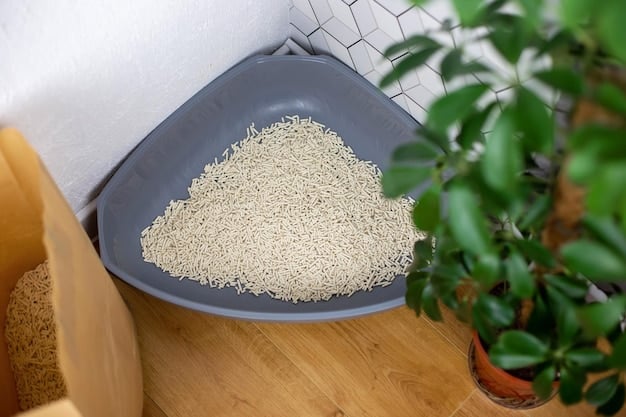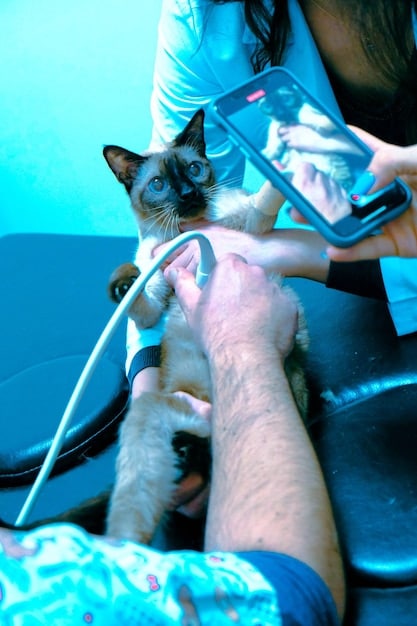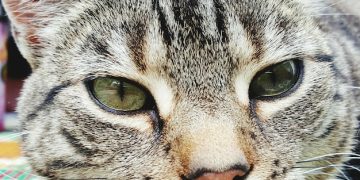3 Litter Box Signs Your Cat Needs a Vet & How to Help

Changes in your cat’s litter box habits can be subtle indicators of underlying health issues; observing frequency, consistency, and urine appearance can provide crucial insights for early veterinary intervention and improved feline well-being.
Is your feline friend’s litter box routine suddenly different? Seemingly minor changes in your cat’s litter box habits, such as frequency, consistency, or even the types of urine clumps, could be significant indicators of underlying health issues. Understanding these 3 Signs Your Cat’s Litter Box Habits Indicate a Serious Health Issue (and What to Do) is crucial for early detection and timely veterinary care, ensuring your beloved kitty remains healthy and happy.
Decoding Your Cat’s Litter Box Habits: An Introduction
Cats are creatures of habit, especially when it comes to their litter box routine. Any noticeable deviation from their norm should raise a flag. While occasional changes may be due to stress or a change in diet, persistent alterations often point to underlying health problems. By paying close attention to your cat’s litter box habits, you can become a proactive advocate for their well-being.
This article will delve into three key signs observed in the litter box that may suggest a serious health issue in your cat and what steps you should take.
Sign #1: Changes in Frequency and Volume
One of the first clues to your cat’s health lies in how often they visit the litter box and the amount of waste they produce. An increase or decrease in either urine or stool volume can be a sign of trouble.
Increased Urination (Polyuria)
If you notice your cat is suddenly urinating more frequently or producing larger volumes of urine, it could be a sign of several conditions.
Decreased Urination (Oliguria) or Straining to Urinate
Conversely, a decrease in urination, or observing your cat straining to urinate without producing much, is a serious concern.
- Possible Causes: Urinary tract infections (UTIs), bladder stones, urethral obstruction (especially in male cats), kidney disease.
- What to Do: Seek immediate veterinary attention. Urethral obstruction is a medical emergency.
- Monitoring Tips: Observe your cat closely for signs of discomfort, vocalization while urinating, or blood in the urine. Also, keep track of how frequently you are cleaning the litter box.

Changes in the frequency and volume of urination, whether increased or decreased, can signal problems ranging from kidney disease to life-threatening urinary blockages. Prompt veterinary assessment is essential to determine the underlying cause and implement the appropriate treatment.
Sign #2: Consistency and Appearance of Stool
The consistency and appearance of your cat’s stool provide valuable information about their digestive health. Normal cat stool should be well-formed and firm but not hard.
Diarrhea
Diarrhea, characterized by loose or watery stools, is a common sign of digestive upset in cats. While a single episode of diarrhea may not be cause for alarm, persistent or severe diarrhea warrants veterinary attention.
Constipation
Constipation, on the other hand, involves infrequent or difficult bowel movements, often resulting in hard, dry stools.
- Possible Causes: Dietary issues (too little fiber, dehydration), hairballs, intestinal obstruction, megacolon.
- What to Do: Mild constipation can sometimes be resolved with increased water intake and dietary adjustments (adding fiber). However, severe or persistent constipation requires veterinary intervention.
- Monitoring Tips: Observe your cat for straining to defecate, decreased appetite, and abdominal discomfort.
Consistency is key for stool observation; persistent diarrhea or constipation can indicate underlying issues such as dietary problems or intestinal obstructions. Consulting with a veterinarian will help determine the root cause and best course of action for managing your cat’s digestive health.
Sign #3: Blood in Urine or Stool
The presence of blood in your cat’s urine (hematuria) or stool (hematochezia or melena) is always a cause for concern and warrants immediate veterinary evaluation.
Blood in Urine (Hematuria)
Hematuria can indicate a variety of urinary tract issues, ranging from mild infections to serious conditions like bladder cancer.
Blood in Stool (Hematochezia or Melena)
The appearance and color of blood in the stool can provide clues about the location of the bleeding.
- Possible Causes: UTIs, bladder stones, trauma, bleeding disorders, inflammatory bowel disease (IBD), intestinal parasites, tumors.
- What to Do: Seek immediate veterinary attention. Blood in urine or stool is a serious sign that requires prompt diagnosis and treatment.
- Monitoring Tips: Note the amount and color of blood, as well as any other accompanying symptoms (straining, pain, lethargy).

Spotting blood in your cat’s urine or stool is an immediate cause for concern and requires a veterinary visit. Depending on the location and cause of the bleed, further tests and treatments should be done without delay.
Other Subtle Litter Box Changes to Watch For
Beyond the three main signs discussed above, there are other subtle litter box changes that you should pay attention to.
Changes in Litter Box Preference
Has your cat suddenly started avoiding their usual litter box, or urinating/defecating outside the box in new locations? This could indicate a problem with the litter box itself (dirty, wrong type of litter), a medical issue (pain associated with using the box), or behavioral issues (stress, anxiety).
Vocalization or Discomfort While Using the Litter Box
If your cat vocalizes (cries, meows, or howls) while using the litter box, it suggests they are experiencing pain or discomfort. This is particularly concerning if they are straining to urinate or defecate.
Changes in Litter Box Odor
While cat urine naturally has a distinct odor, a sudden change in the smell of the litter box could indicate a bacterial infection or other health problem.
It is important not to dismiss any changes in your cat’s behavior or routine. Regular observation can help identify signs of health problems early, leading to timely treatments and a better quality of life.
What to Do If You Notice Changes
If you observe any of the litter box changes mentioned above, it’s important to take prompt action. Here’s a step-by-step guide:
Consult Your Veterinarian
The first and most important step is to schedule an appointment with your veterinarian. Explain the changes you’ve observed in detail, including when they started, how often they occur, and any other relevant symptoms. Your vet will perform a physical exam and run diagnostic tests (blood work, urine analysis, fecal analysis, X-rays, or ultrasound) to determine the underlying cause of the problem.
Provide a Detailed History
To help your veterinarian make an accurate diagnosis, provide a detailed history of your cat’s health and lifestyle. This includes their age, breed, diet, vaccination status, any previous medical conditions, and any recent changes in their environment or routine.
Follow Veterinary Recommendations
Once your vet has diagnosed the problem, follow their recommendations carefully. This may involve medications, dietary changes, surgery, or other treatments. Be sure to administer medications as prescribed and attend follow-up appointments as scheduled.
The most important thing is to consult your veterinarian as soon as you notice changes in your cat’s habits. Timely intervention can make a significant difference in the outcome.
| Key Point | Brief Description |
|---|---|
| 💧 Frequency Changes | Increased or decreased urination can signal kidney issues or blockages. |
| 💩 Stool Consistency | Diarrhea or constipation may indicate dietary problems or intestinal concerns. |
| 🩸 Blood in Waste | Blood in urine or stool requires immediate veterinary attention. |
| 😾 Litter Avoidance | Sudden aversion to the litter box may indicate pain or discomfort. |
Frequently Asked Questions (FAQ)
▼
Urinating outside the litter box can stem from medical issues like UTIs or bladder stones, or behavioral factors such as stress, anxiety, or dissatisfaction with the litter box environment. A vet visit is recommended to rule out medical concerns.
▼
Signs of constipation include straining to defecate, infrequent bowel movements, and hard, dry stools. Your cat might also exhibit signs of discomfort or decreased appetite. Dietary changes or a vet visit may be necessary.
▼
Blood in your cat’s urine (hematuria) can be very alarming and is usually an indicator of a urinary tract infection, cystitis, bladder stones, or even a tumor. A veterinary evaluation is essential for prompt diagnosis and treatment.
▼
Occasional mild diarrhea can be due to dietary indiscretion or stress, but persistent or severe diarrhea can signal infections, parasites, or inflammatory bowel disease. It’s best to consult a vet if diarrhea lasts more than a day.
▼
The litter box should be scooped daily to remove solid waste and clumps. A complete litter change and box cleaning should occur weekly, or more frequently if you have multiple cats, to maintain hygiene, and avoid litter box aversion.
Conclusion
Monitoring your cat’s litter box habits is a simple yet effective way to stay on top of their health. By understanding the significance of changes in frequency, consistency, and the presence of blood, you can take proactive steps to ensure your feline friend receives the care they need for a long and happy life.





